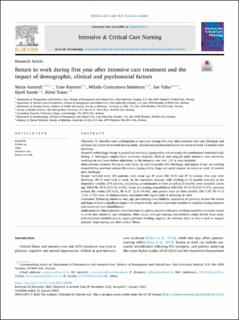| dc.description.abstract | Objectives
To describe work participation in survivors during first year after intensive care unit discharge and examine the impact of selected demographic, clinical and psychosocial factors on return to work 12 months after discharge.
Research methodology/Design
A predefined sub-study (prospective cohort study) of a randomised controlled trial.
Setting
A Norwegian single-centre university hospital. Medical and surgical adult intensive care survivors, working/on sick leave before admission, in the intensive care unit ≥24 h, were included.
Main outcome measures
Return to work three, six and 12 months after discharge, and impact of age, pre-existing comorbidities, previous serious life events, coping ability, hope and social support on return to work 12 months after discharge.
Results
Included were 284 patients, with mean age 47 years (SD 13.9) and 47 % women. One year after discharge, 69 % were back at work. In the regression analysis, with working at 12 months (yes/no) as the dependent variable, 178 patients, completing questionnaires at three as well as 12 months, were included. Lower age (OR 0.96, 95 % CI [0.93–0.99]), lower pre-existing comorbidities (OR 0.65, 95 % CI [0.43–0.97]), previous serious life events (OR 6.53, 95 % CI [2.14–19.94]), and greater hope at three months (OR 1.09, 95 % CI [1.01–1.17]) were all independently associated with higher odds of returning to work.
Conclusion
Following intensive care, age, pre-existing comorbidities, experience of previous serious life events and hope all have a significant impact on return to work, and are important variables to consider during intensive care treatment and rehabilitation.
Implications for clinical practice
Attention must be paid to patients with prior working capability to ensure return to work after intensive care treatment. Older adults with pre-existing comorbidities might benefit from early, individualised rehabilitation to regain previous working capacity. In addition, there is also a need to support patients’ hope during and after critical illness. | |
